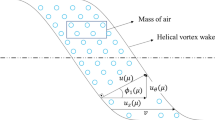Abstract
The application of genetic programming for closed-loop wake stabilization downstream of a triangular cluster of three rotating cylinders, referred to as the fluidic pinball, is investigated experimentally. The implementation of unsteady actuation for control is considered and the benefits over steady control Raibaudo (Phys Fluids 32:015108, 2020) discussed. Experiments are performed at Reynolds number Re \(\approx \) 2200. Two-component planar PIV measurements and hot-wire anemometry are used to characterize the wake with and without actuation. Each cylinder is controlled independently, and the rotation speed is sinusoidally modulated. Linear genetic programming is implemented for the optimization of feedback controllers. Two objectives are considered: drag reduction or wake symmetrization, for which two cost functions \({\mathcal {J}}\) are defined. Open-loop control using sinusoidal modulation is performed to study the efficiency of unsteady actuation compared to constant rotation speeds. Genetic programming is shown to be more efficient than traditional methods for optimization of a large number of control parameters. For the fluidic pinball, optimal solutions are found to be more robust when compared to open-loop genetic algorithms.
Graphic abstract















Similar content being viewed by others
References
Apelt CJ, West GS (1975) The effects of wake splitter plates on bluff-body flow in the range 10 4 \(<\) R \(<\)5 \(\times \) 10 4. Part 2. J Fluid Mech 71(1):145–160
Bansal MS, Yarusevych S (2017) Experimental study of flow through a cluster of three equally spaced cylinders. Exp Ther Fluid Sci 80:203–217. https://doi.org/10.1016/j.expthermflusci.2016.08.016 (ISSN 08941777)
Bartlett MS (1950) Periodogram analysis and continuous spectra. Biometrika 37:1–16
Bingham C, Raibaudo C, Morton C, Martinuzzi R (2018) Suppression of fluctuating lift on a cylinder via evolutionary algorithms: control with interfering small cylinder. Phys Fluids 30(12):1–14. https://doi.org/10.1063/1.5055016 (ISSN 10897666)
Brackston R, García de la Cruz J, Wynn A, Rigas G, Morrison J (2016) Stochastic modelling and feedback control of bistability in a turbulent bluff body wake. J Fluid Mech 802:726–749. https://doi.org/10.1017/jfm.2016.495
Cattafesta LN, Sheplak Mark (2011) Actuators for active flow control. Ann Rev Fluid Mech 43(1):247–272. https://doi.org/10.1146/annurev-fluid-122109-160634 (ISSN 0066-4189)
Choi S, Choi H, Kang Sangmo (2002) Characteristics of flow over a rotationally oscillating cylinder at low Reynolds number. Phys Fluids 14(2):2767–2777
Comte-Bellot G (1976) Hot-wire anemometry. Ann Rev Fluid Mech 8(1):209–231. https://doi.org/10.1146/annurev.fl.08.010176.001233 (ISSN 0066-4189)
Duriez T, Brunton S, and Noack BR (2016) Machine learning control — taming nonlinear dynamics and turbulence. Number 116 in fluid mechanics and its applications. Springer-Verlag
Fujisawa N, Nakabayashi T (2002) Neural network control of vortex shedding from a circular cylinder using rotational feedback oscillations. J Fluids Struct 16(1):113–119
Gad-el hak M (2000) Flow control: passive, active and reactive flow management. Cambridge edition
Gautier N, Aider JL, Duriez T, Noack BR, Segond M, Abel M (2015) Closed-loop separation control using machine learning. J Fluid Mech 770:442–457. https://doi.org/10.1017/jfm.2015.95 (ISSN 14697645)
Kiya M, Shimizu M, Mochizuki O, Ido Y, and Ogura Y (1992) Active control of a turbulent separated flow zone. In: XVIIIth ICTAM, pages 1–13, Haifa, Israel
Lam K, Cheung WC (1988) Phenomena of vortex shedding and flow interference of three cylinders in different equilateral arrangements. J Fluid Mech 196:1. https://doi.org/10.1017/S0022112088002587 (ISSN 0022-1120)
Li S, Yangming Li B, Liu B, Murray Timmy (2012) Model-free control of Lorenz chaos using an approximate optimal control strategy. Commun Nonlinear Sci Numer Simul 17(12):4891–4900. https://doi.org/10.1016/j.cnsns.2012.05.024 (ISSN 10075704)
Li R, Noack BR, Cordier L, Borée Jacques, Harambat Fabien (2017) Drag reduction of a car model by linear genetic programming control. Exp Fluids 58(8):1–20. https://doi.org/10.1007/s00348-017-2382-2 (ISSN 07234864)
Lu X-Y, Sato J (1996) A numerical study of flow past a rotationally oscillating circular cylinder. J Fluids Struct 10(8):829–849. https://doi.org/10.1006/jfls.1996.0055
Milano M, Koumoutsakos Petros (2002) A clustering genetic algorithm for cylinder drag optimization. J Comput Phys 175:79–107. https://doi.org/10.1006/jcph.2001.6882
Moghtadaei M, HashemiGolpayegani MR (2012) Complex dynamic behaviors of the complex Lorenz system. Sci Iran 19(3):733–738. https://doi.org/10.1016/j.scient.2010.11.001 (ISSN 10263098)
Protas B, Wesfreid Jose Eduardo (2002) Drag force in the open-loop control of the cylinder wake in the laminar regime. Phys Fluids 14(220):810–826. https://doi.org/10.1063/1.1432695
Rabault J, Kuhnle Alexander (2019) Accelerating deep reinforcement learning strategies of flow control through a multi-environment approach. Phys Fluids 31(9):094105. https://doi.org/10.1063/1.5116415 (ISSN 1070-6631)
Raibaudo C, Zhong P, Noack BR, Martinuzzi RJ (2020) Machine learning strategies applied to the control of a fluidic pinball. Phys Fluids 32(1):015108. https://doi.org/10.1063/1.5127202 (ISSN 1070-6631)
Roussopoulos Kimon (1993) Feedback control of vortex shedding at low Reynolds numbers. J Fluid Mech 248:267–296
Sparrow C (2012) The Lorenz equations: bifurcations, chaos, and strange attractors. Springer s edition
Terra W, Sciacchitano A, Scarano F (2016) Aerodynamic drag of transiting objects by large-scale tomographic-PIV. In: 18th international symposium on the application of laser and imaging techniques to fluid mechanics, Lisbon, Portugal. https://doi.org/10.1007/s00348-017-2331-0
Wang C, Tang H, Simon CM, Duan F (2017) Lock-on of vortex shedding to a pair of synthetic jets with phase difference. Phys Rev Fluids 2(10):1–26. https://doi.org/10.1103/PhysRevFluids.2.104701
Acknowledgements
The authors acknowledge the technical support for the experimental setup design of Peng Zhong, and for PIV measurements of D\(^{\mathrm {r}}\) Chris Morton and Matthew Gordon Kindree. Thanks to P\(^{\mathrm {r}}\) Bernd R. Noack and D\(^{\mathrm {r}}\) Ruiying Li for interesting discussions about linear genetic programming. The present work is supported by the senior author’s (R. J. Martinuzzi) NSERC discovery grant. C. Raibaudo acknowledges the financial support of the University of Calgary Eyes-High PDF program. Funding was provided by Natural Sciences and Engineering Research Council of Canada (Grant No. 04079) and Canada Foundation for Innovation (Grant No. 34707).
Author information
Authors and Affiliations
Corresponding author
Additional information
Publisher's Note
Springer Nature remains neutral with regard to jurisdictional claims in published maps and institutional affiliations.
Rights and permissions
About this article
Cite this article
Raibaudo, C., Martinuzzi, R.J. Unsteady actuation and feedback control of the experimental fluidic pinball using genetic programming. Exp Fluids 62, 219 (2021). https://doi.org/10.1007/s00348-021-03309-1
Received:
Revised:
Accepted:
Published:
DOI: https://doi.org/10.1007/s00348-021-03309-1




